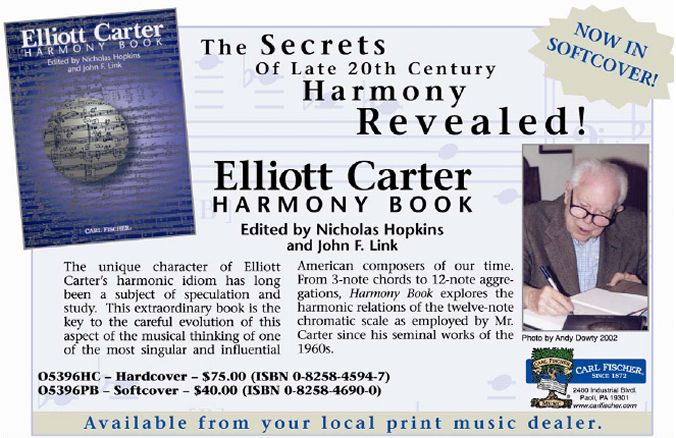|
|
Your
Ad Here!
Send Email to: publisher@newmusicon.org |
|
|
Your
Ad Here!
Send Email to: publisher@newmusicon.org |
CONTENTSPUSHING THE ENVELOPE:
The New Music Champion
Award, 4 THE HONOREES, 5 ALL ON BOARD, 6 LIVE EVENTS Clothed
in a Redemptive Tale (Paulk on Heggie), 10
DOTTED NOTES from … Kroll, Pehrson, BLC, 17 LEGATO NOTES:
More on Board, 19 THE SCOREBOARD:
THE CINEMA;
RECORDINGS: Mixing History and
Mystery Electronically (BLC on Martin Gotfrit),
24 RECENT RELEASES, 25 COMPOSER INDEX, 25
BRAVI TO …, 27
THE PUZZLE PAGE: |
Nightstallions?Peter Kroll ©2004 Ned Rorem: Lions (A Dream) ~~ David Schober: Split Horizon ~~ Daron Hagen: Fire Music ~~ Nicholas Maw: The World in the Evening. eighth blackbird; Steven Sloane, American Composers Orch. Carnegie Hall. March 10th. The ACO's second subscription concert of the season was subtitled 'Fanfare and Fire.' There was nothing explicit in the program notes about this theme, but the titles of the works seemed to indicate its thread. Rorem writes that his 14-minute work was composed in 1963 and was "from a poem written 20 years ago following a dream. That poem is lost, but the dream re-mains clearly still." It is a compelling, sometimes frightening work, not unlike dreams. The composer utilizes hymn tunes and harshly dissonant screams of brass and the orchestra as a whole. The hymn-like theme becomes an ostinato line underneath a wailing and lyrical interlude high-lighting the soprano sax. In its development, it turns, floating in and out of hearing, followed by Straussian "Quixote sheep." The jazz riffs con-tinue and the work ends hauntingly. Schober writes that he "has always been fascinated by borders...and the coexistence of perceived opposites." The title of his 21-minute composition " is a provocative image drawn from the poetry of Thomas Lux." The work also is influenced by the paintings of the 14th Century Chinese painter Ni Tsan who used a split per-spective. The composer indicates that the "stage horizon is split between sextet and orchestra; the four movements explore the warmth and cold, friction and flow between them (and that) the heart of Split Horizon is eighth blackbird", which uses winds, strings, piano and percus-sion. and functions "like a solo hyper-instrument". It handled its challenges virtuosi-cally: scurrying phrases, jazzy riffs, atonal dis-sonances. Schober indicates that the work "fuses the intimacy and precision of chamber music with an orchestral palette of sound-colors." The orchestra is kept busy too but mainly as an accompanist. The work mixes a powerful, sometimes raucus sound world with softness, but both are handled inventively. Hagen's 9-minute composition derives from the composer's opera about Frank Lloyd Wright. Hagen notes how important fire was in Wright's life. He writes that the work has four ideas: the first and "the core of Fire Music is a four note-cell, heard right at the beginning, that grows into a snake-like worm…; the second is a driving rhythmic cell…; the third is a faux Protestant hymn while the fourth idea is the theme that, in the opera, Wright uses to pitch his plan. The four are presented in collage." This is done imaginatively and compellingly: bee-like arpeggios are heard in conjunction with rich, brassy Hollywood themes and Virgil Thomson-like simple harmonies. Wagner's own fire music is evident towards the end. The whole is much more than the sum of its parts. Maw describes his 29-minute piece as evoking a general feeling of evening in several different senses: a time of day, a time of life, a state of mind… According to the program notes the work, subtitled Lullaby for Orchestra, "is in one continuous movement (and uses the orchestra) as an organic ensemble of extraordinary richness." Its opening lullaby is dark but not ominous. A striking use of pizzicato with brass in the background is enthralling. The work develops slowly and includes a middle section which is loudly and brassily insistent. Though somewhat meandering, it moves onto a lovely cello line with flute obbligato and ends with a wonderfully dreamy and hazy softness. It would be good to hear it again. I note with regret that the ACO's move to Wednesday nights continues to draw smaller audiences. The orchestra played up to its usual excellent level. |
